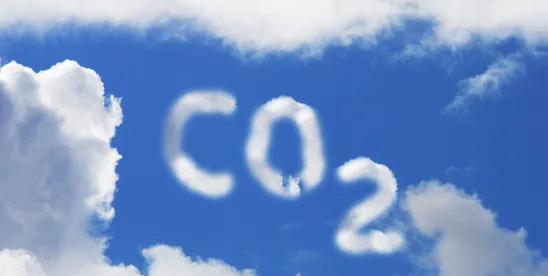Affected Industries
- Carbon Project Developers
- Forestry
- Agriculture
- Renewable Energy
- Environmental Remediation
Senate Draft of BBB Would Standardize and Reduce Value of 45Q Credit, Diminishing Incentives for Long-Term Carbon Storage
The Senate’s draft of the “One Big Beautiful Bill” (BBB) proposes several material changes to Section 45Q of the Internal Revenue Code (IRC) that would significantly affect carbon capture and storage (CCS) project developers, including provisions of Section 45Q related to credit values and inflation adjustment.
Key Takeaways
The Senate draft of the BBB would:
- Prohibit certain foreign entities from claiming the 45Q credit. This proposed prohibition aligns with broader efforts to restrict access to tax incentives and prioritize tax credit eligibility by domestic entities.
- Maintain project eligibility under 45Q, preserving the types of projects that can qualify for the credit.
- Standardize the credit value at $17 per metric ton across all eligible CCS project types, eliminating the current tiered structure that favors secure geological storage. The proposed change removes the distinction between project types and shifts focus to the use of carbon oxide, rather than the specific storage or utilization method. Currently, the base credit is:
- $17/ton for carbon oxide disposed of in secure geological storage
- $12/ton for carbon oxide used as a tertiary injectant or otherwise utilized.
- Maintain the existing 5x bonus multiplier for projects meeting prevailing wage and apprenticeship requirements, resulting in a potential total credit of up to $85/ton (5 x $17) for all eligible CSC projects.
- Change the base year for annual inflation adjustment from 2025 to 2026. This subtle change could result in a meaningful reduction in credit value for projects entering service in later years.
- Reduce the benefit to Direct Air Capture (DAC) facilities by setting a flat credit of $26/ ton across all eligible DAC project categories. This reduction would represent a nearly 28% cut to DAC storage incentives for DAC used in secure geological storage and would eliminate the policy signal that favors long-term storage over other storage or commercial uses. Currently, DAC projects receive:
- $36/ton for carbon oxide stored in secure geological storage
- $26/ton for carbon oxide used in tertiary injection or otherwise utilized.
- Maintain the 5x multiplier for DAC projects, resulting in a maximum credit of up to $130/ton (5 x $26). This is a significant reduction from the current maximum credit of up to $180/ton (5 x $36) for DAC projects utilizing secure geological storage.
- Continue to allow transferability of the credit, enabling project developers to sell all or a portion of the credit to unrelated third parties. This is important for project financing because transferability allows project developers to fully leverage the value of tax credits they might not otherwise be able to use themselves, or to seek forms of tax credit financing.
Eligible Projects
Projects eligible for the 45Q credit under the Senate draft of the BBB would remain limited to projects capturing carbon oxide using carbon capture equipment and which:
- Dispose of the carbon oxide in secure geological storage (and not as tertiary injectant or other utilization described below);
- Use the carbon oxide as a tertiary injectant in a qualified enhanced oil or natural gas recovery project and dispose of it in secure geological storage; or
- Utilize the carbon oxide through:
- Fixation through photosynthesis or chemosynthesis (e.g., growing algae or bacteria),
- Chemical conversion to a material or chemical compound in which the carbon oxide is securely stored, or
- Use for any other purpose for which a commercial market exists (excluding tertiary injection).
Next Steps
The legislation is currently under consideration by the Senate Committee on Finance.
Development of Federal Biochar Program
The House of Representatives recently passed legislation that includes the creation of Section 301- Biochar Innovations and Opportunities for Conservation, Health, and Advancements in Research, a sweeping provision aimed to foster the development, commercialization, and scientific application of biochar through public-private partnerships, grant funding, and research initiatives.
Key Takeaways
- If enacted into law, the legislation would authorize federal demonstration projects nationwide, led by the U.S. Forest Service, Bureau of Land Management, and Department of Energy (DOE).
- State, local, and tribal governments, academic institutions, non-profit organizations, private companies, and public-private partnerships may propose potential projects.
- Projects would be prioritized that:
- Stimulate job creation in rural communities;
- Demonstrate marketable or restorative uses of biochar (e.g., wildfire risk reduction, soil and watershed improvement);
- Are located in areas with high wildfire risk, abundant biomass feedstock, or high demand for biochar or its byproducts.
- Funding could be used for:
- Constructing or upgrading biochar facilities (federal share capped at 35% of total capital cost);
- Feedstock acquisition and testing;
- Research, development, and product innovation; or
- Demonstrating environmental and market benefits of biochar.
Next Steps
The legislation is currently under consideration in the Senate Committee on Agriculture, Nutrition, and Forestry.
Development of Forest Residues Carbon Tax Credit
Senator Sheldon Whitehouse and Representative Adam Schiff have introduced a new bill to create a federal tax credit aimed at incentivizing carbon removal and storage through the use of forest residues collected during wildfire mitigation efforts.
Key Takeaways
- The new tax credit would equal (1) $36/metric ton for carbon stored in secure geological storage or (2) $12/metric ton for carbon stored in other long-duration utilization (e.g., biochar, durable materials, etc.).
- Eligible projects would be eligible for a 5x multiplier for meeting certain enhanced criteria (i.e., prevailing wage and apprenticeship requirements).
- No double dipping with other tax credits. This new tax credit would address a gap in the existing tax credits and would not apply to carbon removal and storage projects already receiving tax credits for CCS or other activities eligible for the 45Q tax credit.
Eligible Projects
- Projects would be required to utilize biomass equipment to capture carbon from qualified forest residues (small-diameter trees, limbs, bark, and other residues from wildfire hazard reduction).
- Projects would need to sequester a minimum of 1,000 metric tons of carbon dioxide equivalent stored per year.
- Projects would need to be in the U.S. or U.S. territories.
Next Steps
Although the bill is unlikely to advance in its current form through either chamber given the current makeup of Congress, the introduction of this bill reflects a growing recognition of the gaps in federal tax policy related to carbon dioxide removal (CDR) projects—particularly those involving forest residues and other biomass feedstocks. Under existing programs such as the Section 45Q carbon oxide sequestration credit, Section 45Y clean electricity production tax credit, Section 48 investment tax credit, and the Section 48E clean electricity investment tax credit, projects must meet stringent technical eligibility requirements that could be interpreted to exclude or at least complicate eligibility for forest biomass-based carbon sequestration efforts.
Projects that aim to utilize forest residues for durable carbon sequestration—through pathways like biochar production, biomass burial, or bioenergy with carbon capture and storage (BECCS)—must be carefully structured to ensure compliance with technical, measurement, and permanence criteria to qualify for tax credit incentives.
Conclusion
The direction of federal carbon policy is shifting toward utilization-focused, market-driven, and technology-neutral approaches. Recent Congressional action appears to align with the current Administration’s broader priorities of energy independence, economic competitiveness, and reduced regulatory burdens. This trend, in part, helps to explain reductions in DAC credit levels.
Rather than promoting climate policy through top-down mandates, the Trump administration and Congress are favoring policies that reward tangible economic use of carbon, such as industrial CO2 utilization and land-based carbon storage with co-benefits to agriculture and forestry. This approach embraces carbon as a commodity, not a liability – supporting projects that create domestic jobs, leverage U.S. natural resources, and enhance energy infrastructure.
Going forward, expect to see support for carbon initiatives that:
- Prioritize utilization and durability over climate change metrics;
- Reinforce U.S. manufacturing, agriculture, and energy sectors;
- Avoid regulatory overreach by relying on voluntary, incentive-based frameworks.
Carbon policy is not going away – but it is being reshaped in important ways. We expect more of this in the coming years and months, with a potential further focus on carbon markets and other environmental commodities.









 />i
/>i
